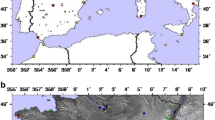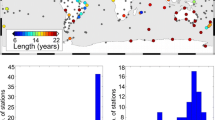Abstract
The diurnal cycle of the tropospheric zenith total delay (ZTD) is one of the most obvious signals for the various physical processes relating to climate change on a short time scale. However, the observation of such ZTD oscillations on a global scale with traditional techniques (e.g. radiosondes) is restricted due to limitations in spatial and temporal resolution. Nowadays, the International GNSS Service (IGS) provides an important data source for investigating the diurnal and semidiurnal cycles of ZTD and related climatic signals. In this paper, 10 years of ZTD data from 1997 to 2007 with a 2-hour temporal resolution are derived from global positioning system (GPS) observations taken at 151 globally distributed IGS reference stations. These time series are used to investigate diurnal and semidiurnal oscillations. Significant diurnal and semidiurnal oscillations of ZTD are found for all GPS stations used in this study. The diurnal cycles (24 hours period) have amplitudes between 0.2 and 10.9 mm with an uncertainty of about 0.5 mm and the semidiurnal cycles (12 h period) have amplitudes between 0.1 and 4.3 mm with an uncertainty of about 0.2 mm. The larger amplitudes of the diurnal and semidiurnal ZTD cycles are observed in the low-latitude equatorial areas. The peak times of the diurnal cycles spread over the whole day, while the peak value of the semidiurnal cycles occurs typically about local noon. These GPS-derived diurnal and semidiurnal ZTD signals are similar with the surface pressure tides derived from surface synoptic pressure observations, indicating that atmospheric tides are the main driver of the diurnal and semidiurnal ZTD variations.
Similar content being viewed by others
References
Behrend D, Cucurull L, Vila J, Haas R (2000) An inter-comparison study to estimate zenith wet delays using VLBI, GPS and NWP models. Earth Planets Space 52(10): 691–694
Beutler G, Rothacher M, Schaer S, Springer TA, Kouba J, Neilan RE (1999) The International GPS service (IGS): An interdisciplinary service in support of earth sciences. Adv Space Res 23: 631–653. doi:10.1016/S0273-1177(99)00160-X
Bevis M, Businger S, Chiswell S, Herring TA, Anthes RA, Rocken C et al (1994) GPS meteorology: mapping zenith wet delays onto precipitable water. J Appl Met 33: 379–386 doi:10.1175/1520-0450(1994)033<0379:GMMZWD>2.0.CO;2
Byun SH, Bar-Sever Y, Gendt G (2005) The new tropospheric product of the International GNSS service, paper presented at 2005 ION GNSS conference, Inst. of Navig., Long Beach, CA
Chapman S, Lindzen RS (1970) Atmospheric tides. Gordon and Breach, New York
Dach R, Dietrich R (2000) Influence of the ocean loading effect on GPS derived precipitable water vapor. Geophy Res Lett 27(18): 2953–2956. doi:10.1029/1999GL010970
Dai A, Wang J (1999) Diurnal and semidiurnal tides in global surface pressure fields. J Atmos Sci 56: 3874–3891 doi:10.1175/1520-0469(1999)056<3874:DASTIG>2.0.CO;2
Dai A, Wang J, Ware RH, Van Hove T (2002) Diurnal variation in water vapor over North America and its implications for sampling errors in radiosonde humidity. J Geophys Res 107(D10): 4090. doi:10.1029/2001JD000642
Davis J, Herring TA, Shapiro II, Rogers AEE, Elgered G (1985) Geodesy by radio interferometry: effects of atmospheric modeling errors on the estimates of baseline lengths. Radio Sci. 20: 1593–1607. doi:10.1029/RS020i006p01593
Deblonde G, Macpherson S, Mireault Y, Heroux P (2005) Evaluation of GPS precipitable water over Canada and the IGS network. J Appl Met 44: 153–166. doi:10.1175/JAM-2201.1
Duan J, Bevis M, Fang P, Bock Y, Chiswell S, Businger S et al (1996) GPS meteorology: direct estimation of the absolute value of precipitable water. J Appl Met 35: 830–838 doi:10.1175/1520-0450(1996)035<0830:GMDEOT>2.0.CO;2
Elgered G, Johansson JM, Rönnäng BO, Davis JL (1997) Measuring regional atmospheric water vapor using the Swedish permanent GPS network. Geophy Res Lett 24: 2663–2666. doi:10.1029/97GL02798
Emardson TR, Elgered G, Johansson JM (1998) Three Months of Continuous Monitoring of Atmospheric Water Vapor with a Network of GPS Receivers. J Geophys Res 103: 1807–1820. doi:10.1029/97JD03015
Gendt G, Dick G, Reigber C, Tomassini M, Liu Y, Ramatschi M (2004) Near real time GPS water vapor monitoring for numerical weather prediction in Germany. J Met Soc Jpn 82: 361–370. doi:10.2151/jmsj.2004.361
Hagemann S, Bengtsson L, Gendt G (2003) On the determination of atmospheric water vapor from GPS measurements. J Geophys Res 108(D21): 4678. doi:10.1029/2002JD003235
Hernandez-Pajares M, Juan JM, Sanz J, Colombo OL, van der Marel H (2001) A new strategy for real-time integrated water vapor determination in WADGPS networks. Geophy Res Lett 28(17): 3267–3270. doi:10.1029/2001GL012930
Humphreys TE, Kelley MC, Kintner PM Jr (2004) GPS-based measurements of atmospheric tides, paper presented at 2004 ION GNSS Conferences, Ins of Nav, Long Beach, CA, 21–24 Sept
Humphreys TE, Kelley MC, Huber N, Kintner PM Jr (2005) The semidiurnal variation in GPS-derived zenith neutral delay. Geophys Res Lett 32: L24801. doi:10.1029/2005GL024207
Jin SG, Park J, Cho J, Park P (2007) Seasonal variability of GPS-derived Zenith Tropospheric Delay (1994–2006) and climate implications. J Geophys Res 112: D09110. doi:10.1029/2006JD007772
King RW, Bock Y (2005) Documentation for the GAMIT GPS Analysis Software. Mass. Inst. of Technol., Cambridge
Kuo YH, Guo R, Westwater ER (1993) Assimilation of precipitable water measurements into a mesoscale model. Mon Weather Rev 121: 1215–1238 doi:10.1175/1520-0493(1993) 121<1215:AOPWMI>2.0.CO;2
Lyard F, Lefevre F, Letellier T, Francis O (2006) Modelling the global ocean tides: insights from FES2004. Ocean Dynam 56: 394–415. doi:10.1007/s10236-006-0086-x
McCarthy D, Petit G (eds) (2004) IERS conventions (2003). IERS technical note no 32, Verlag des Bundesamts fur Kartographie und Geodasie, Frankfurt am Main, 127pp
Niell AE (1996) Global mapping functions for the atmosphere delay at radio wavelength. J Geophys Res 101(B2): 3227–3246. doi:10.1029/95JB03048
Pramualsakdikul S, Haas R, Elgered G, Scherneck HG (2007) Sensing of diurnal and semi-diurnal variability in the water vapor content in the tropics using GPS measurements. Met Appl 14: 403–412. doi:10.1002/met.39
Rocken C, Ware RH, Van Hove T, Solheim F, Alber C, Johnson J et al (1993) Sensing atmospheric water vapor with the global positioning system. Geophys Res Lett 20: 2631–2634. doi:10.1029/93GL02935
Saastamoinen J (1973) Contributions to the Theory of Atmospheric Refraction, In three parts. Bull Geod 105:279–298; 106:383–397; 107:13–34
Snajdrova K, Boehm J, Willis P, Haas R, Schuh H (2005) Multi-technique comparison of tropospheric zenith delays derived during the CONT02 campaign. J Geod 79(10–11): 613–623. doi:10.1007/s00190-005-0010-z
Tregoning P, Boers R, O’Brien D (1998) Accuracy of absolute precipitable water vapor estimates from GPS observations. J Geophys Res 103(28): 701–710
Vey S, Calais E, Llubes M, Florsch N, Woppelmann G, Hinderer J et al (2002) GPS measurements of ocean loading and its impact on zenith tropospheric delay estimates: a case study in Brittany, France. J Geod 76: 419–427. doi:10.1007/s00190-002-0272-7
Watson C, Tregoning P, Coleman R (2006) Impact of solid Earth tide models on GPS coordinate and tropospheric time series. Geophys Res Lett 33. doi:10.1029/2005GL025538
Ware RH, Fulker DW, Stein SA, Anderson DN, Avery SK, Clark RD et al (2000) SuomiNet: A real-time national GPS network for atmospheric research and education. Bull Am Met Soc 81: 677–694 doi:10.1175/1520-0477(2000)081<0677:SARNGN>2.3.CO;2
Wu PM, Hamada JI, Mori S, Tauhid YI, Yamanaka MD, Kimura F (2003) Diurnal variation of precipitable water over a mountainous area of Sumatra Island. J Appl Met 42: 1107–1115 doi:10.1175/1520-0450(2003)042<1107:DVOPWO>2.0.CO;2
Author information
Authors and Affiliations
Corresponding author
Rights and permissions
About this article
Cite this article
Jin, S., Luo, O.F. & Gleason, S. Characterization of diurnal cycles in ZTD from a decade of global GPS observations. J Geod 83, 537–545 (2009). https://doi.org/10.1007/s00190-008-0264-3
Received:
Accepted:
Published:
Issue Date:
DOI: https://doi.org/10.1007/s00190-008-0264-3




